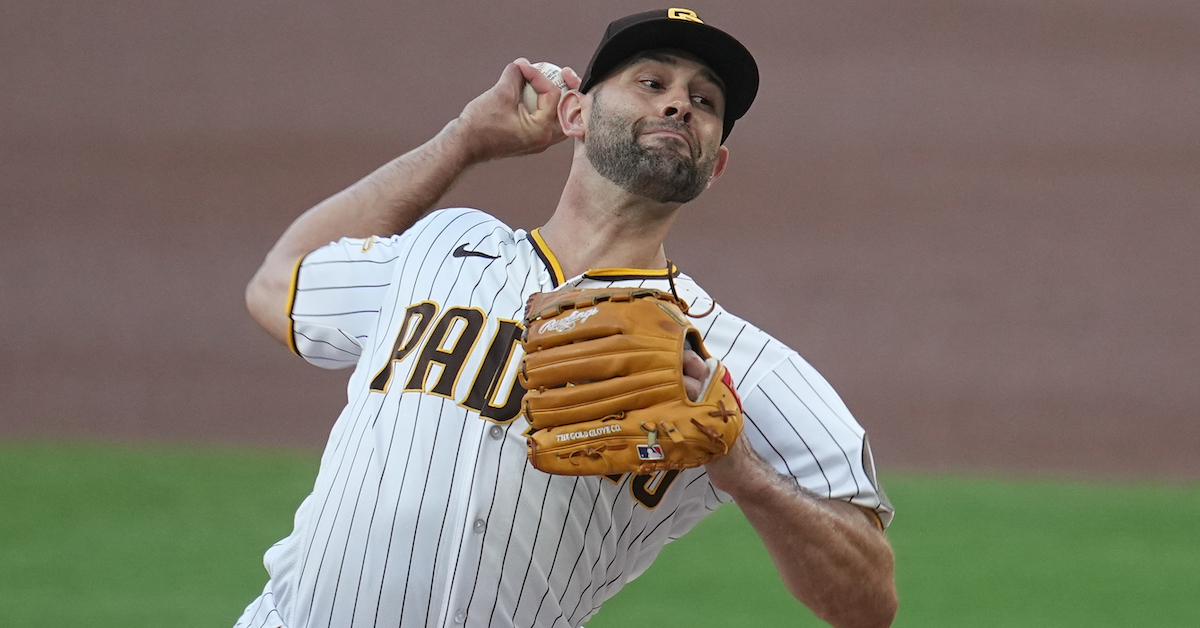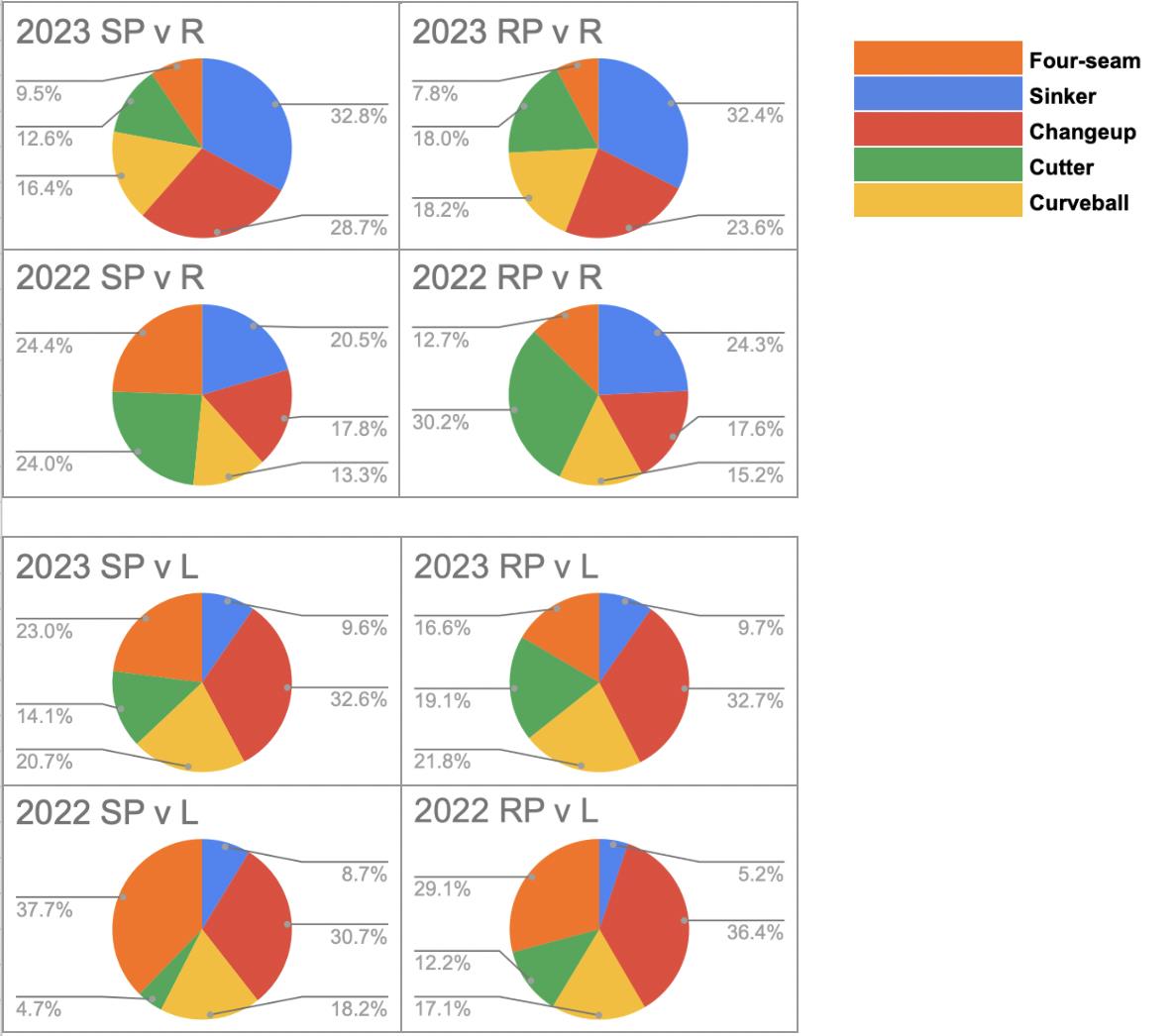
Ray Acevedo-USA TODAY Sports
In the early hours of Thursday morning, the Reds made their second signing in as many days, adding right-handed pitcher Nick Martinez on a two-year, $26 million deal. Evidently, Cincinnati decided to get in on the regional pitching party; of the nine free-agent pitchers to sign MLB deals with new teams so far, six have joined the AL or NL Central. Not to mention that two of the four position players switching teams also came to the Central, and word on the street is that the Brewers are signing top prospect Jackson Chourio to an $80 million extension. The Central division teams, often the most overlooked and underfunded, have been surprisingly active so far this winter.
Martinez, who turned 33 this past August, is coming off the strongest season of his truncated career. Never a top prospect, he struggled over parts of four seasons with the Rangers from 2014 to ’17, posting a 4.77 ERA and 0.5 WAR in 415.1 innings. He was non-tendered following the 2017 season, after which he spent four years in Japan, pitching for the Nippon Ham Fighters and the Softbank Hawks of NPB. His 2021 season for the Hawks was particularly impressive; he averaged more than 6.2 innings per game and finished second in the Pacific League in ERA (min. 50 IP), trailing only Yoshinobu Yamamoto. His performance caught the attention of several MLB clubs, and when the lockout ended, he signed a four-year, $25.5 million deal with the Padres that included opt-outs after every single season.
Martinez performed well enough in 2022 to escape his deal at the first chance he got, pitching to a 3.47 ERA and 4.43 FIP in 47 games. His underlying numbers weren’t as impressive as his ERA, and while he pitched in nearly every role — starter, long-man, set-up man, closer — a lot of his success came in lower-leverage relief opportunities. Still, he knew he could do better than the three years and $18 million remaining on his contract, and indeed, only a few days after he opted out, he and the Padres agreed on a richer contract, albeit one still replete with options, team and player alike.
Martinez looked even better in 2023, but his performance wasn’t quite enough to convince the newly cost-conscious Padres to pick up their team option for $32 million over the next two years. At the same time, the righty decided he could do better than his player option for two years and $16 million. His new deal with the Reds splits the difference at $26 million over two years.
Obviously, it wouldn’t be a Nick Martinez contract without an option; this time, he can opt out after the first year of the deal, giving him the chance to re-enter the market at age 34. Could Martinez become the first MLB player to opt out of his contract in three consecutive offseasons? I have no idea how to confirm that information, aside from sending out a Sarah Langs bat signal into the night.
It’s no coincidence that Martinez keeps signing deals with opt-out clauses. There’s no simple way to measure the monetary value of an opt-out, but it’s a player benefit in a contract, so in order get one, players have to sacrifice some guaranteed money, at least in theory. So in each of the last three offseasons, Martinez has bet on himself, giving up that guaranteed money for the chance to increase his value and return to free agency each winter, and so far, that gamble has paid off.
Amusingly enough, Martinez essentially repeated his 2022 performance (44 runs allowed in 106.1 innings) in 2023 (45 runs allowed in 110.1 innings), but he did so in a much trickier offensive environment, as scoring was up by one-third of a run per nine. He slightly increased his strikeout rate and decreased his walk rate, good for a league-average 2.65 K/BB, but his real trick was limiting home runs and extra-base hits, giving up eight fewer doubles and three fewer home runs in a season when the league as a whole hit 288 more doubles and 653 more home runs. He pulled it off by inducing more grounders and giving up fewer pulled fly balls and hard-hit line drives. It’s a simple formula for success, as long you can keep it up.
Batted ball distribution isn’t super stable from year to year, and we’re only working with 110.1 innings of data for Martinez in 2023. Still, he made big changes to his pitch mix this past season, and those changes seem to underlie his success. Here’s how he altered his approach in 2023, broken down by role and opponent handedness:

Pitch Data from Baseball Savant
Martinez leaned on his four-seam fastball when he first came back from Japan, but he started to cut back on the pitch once he moved to the bullpen in 2022, then continued that trend in ’23. Against righties, he largely replaced his four-seamer with his sinker, which helps explain his 90th-percentile groundball rate and 95th-percentile hard-hit rate. Right-handed batters had an average launch angle of 6 degrees against his sinker and managed just a .035 isolated power on it.
Meanwhile, against opposite-handed opponents, Martinez continued to turn to his changeup, which he threw significantly more often than any other pitch. That was clearly the right decision: lefties posted a .181 wOBA against it, whiffing on 42.7% of all swings. He also doubled his cutter usage, and by throwing the pitch a little faster and with added rise, he made it an effective put-away option against left-handed batters. Finally, he slightly upped the usage and refined the movement profile of his unusual curveball against all hitters. The pitch had a ton of drop, almost no horizontal break, and boasted a 74.4% groundball rate.
Overall, Martinez had a similar degree of success against righties and lefties, but he got there in different ways. Facing left-handed hitters, his changeup and cutter helped him generate 10.32 K/9; against righties, his strikeout rate was a more pedestrian 7.48. But his left-handed opponents hit for a slugging percentage more than 100 points higher than their right-handed counterparts. Both the high-strikeout and soft-contact approaches can work, but neither is without its drawbacks. One the one hand, I’m more inclined to believe Martinez’s production against lefties was the real deal; batted ball luck changes with the wind, but you can’t fake all those strikeouts. That said, a pitcher who gives up more home runs to left-handed batters is going to have a harder time at Great American Ball Park than Petco.
According to The Athletic’s C. Trent Rosencrans, Martinez will likely come into spring training as a starter. That shouldn’t come as a surprise, considering he’s begun each of the past two seasons as a starter before moving to the bullpen. Besides, it’s easier to make the transition in that direction than the other. And the Reds’ need for starting pitching trumps their need for bullpen support (which they also just added in the form of Emilio Pagán). They ranked second-last in the National League in starter ERA last season, and only so much of that can be blamed on their hitter-friendly stadium; they also had the fifth-worst xFIP.
The Reds have no shortage of talented young arms on the 40-man roster, but not many they count on. Hunter Greene has a 4.62 ERA over his first two seasons. Nick Lodolo missed almost all of the 2023 season with injury. Graham Ashcraft has flashed above-average stuff in short bursts but by and large looks like a No. 5 starter. Andrew Abbott turned in a strong rookie season but stumbled down the stretch, posting a 6.42 ERA and 4.81 FIP over his final 11 starts. He also struggled to miss bats in the majors and minors. Fellow rookie Brandon Williamson posted a 4.46 ERA and 4.63 FIP in 23 starts; like Ashcraft, it’s hard to see him as much more than a No. 5 starter.
It makes sense why the Reds targeted Martinez. He’s an option for the rotation if the young guys struggle, but he can also step into a bullpen role if enough of them force the issue. But while he is a good fit, he’s not the difference-maker that’s going to get the Reds to the playoffs. For that, they’ll rely on those young players to take another step forward. But without another addition to the rotation, they’ll be asking a lot of from a group of unproven pitchers. Trading for someone like Tyler Glasnow would make a tremendous difference, and the Reds could take on his $25 million without even crossing the $100 million payroll threshold. That shouldn’t be a problem for a team that ran payrolls between $130–$150 million from 2019 to ’21, especially since owner Bob Castellini is reportedly willing to spend this winter. Still, given the team’s stinginess in the recent past and all the uncertainty surrounding Bally Sports, it’s anyone’s guess what kind of budget Nick Krall has to work with.
Source
https://blogs.fangraphs.com/nick-martinez-keeps-his-options-open-signs-with-reds/
 Backyard GrillingWeekend WarriorsAdvice from DadBeard GroomingTV Shows for Guys4x4 Off-Road CarsMens FashionSports NewsAncient Archeology World NewsPrivacy PolicyTerms And Conditions
Backyard GrillingWeekend WarriorsAdvice from DadBeard GroomingTV Shows for Guys4x4 Off-Road CarsMens FashionSports NewsAncient Archeology World NewsPrivacy PolicyTerms And Conditions
